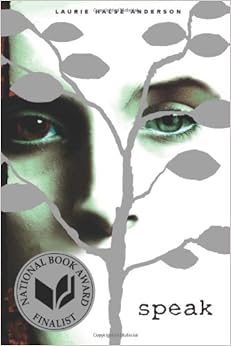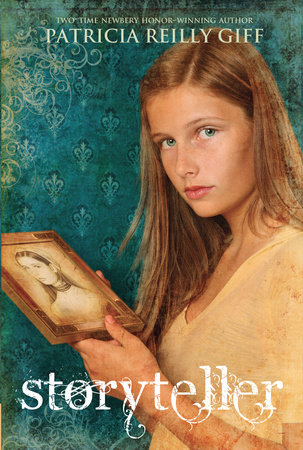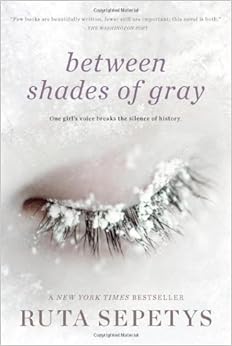by Kate DiCamillo
Image from: http://ecx.images-amazon.com/images/I/51whi5u8GDL._SY344_BO1,204,203,200_.jpg
Bibliography: DiCamillo, Kate. (2013). FLORA AND ULYSSES. Ill. by K.G. Campbell. Mass: Candlewick Press. ISBN 9780763660406
Plot Summary:
Critical Analysis:
The perspective of the illustrations allow the reader to “step into the shoes” of Ulysses, experiencing his world with him. For instance, in one scene Ulysses is seeking out Mrs. Buckman’s typewriter in the darkness of night and typing words to defeat the evil. We are with the squirrel as he types his first word, “Squirtel!” The text weaves a universal truth that transcends time and place, that of good is more powerful than evil, as Flora and Ulysses , together, conquer villains, defend the defenseless, and protect the weak. Although readers will adore the characters, themes of divorce, forgiveness, love and believing in yourself, will support readers needing to hear about such real life events.
Connections:
- Because of Winn-Dixie
- Louise, the Adventures of a Chicken
- The Magician's Elephant
- The Tale of Despereaux: Being the Story of a Mouse, a Princess, Some Soup, and a Spool of Thread
Speak
image from: http://ecx.images amazon.com/images/I/41qap6ztVoL._SY344_BO1,204,203,200_.jpg
Bibliography: Anderson, Laurie Halse. 1999. Speak. New York: RR Donnelley & Sons Company. 978-0312674397
Plot Summary:
Critical Analysis:
A transformation of Melinda is witnessed through the events of her story. We, as the reader, walk with her through high school, and the ups and downs that provides. We are privileged to glimpse into her world, that of a rape victim, and are with her again, as she finds the inner strength to move forward.
Review Excerpt(s):
~"The plot is gripping and the characters are powerfully drawn, but it is its raw and unvarnished look at the dynamics of the high school experience that makes this a novel that will be hard for readers to forget." -Kirkus Reviews
Connections:
- Chains
- Forge
- Fever 1793
- Thank You, Sarah: The Woman Who Saved Thanksgiving
- The Impossible Knife of Memory
Awards and Recognitions:
1999 National Book Award Finalist
2000 SCBWI Golden Kite Award for Fiction
2000 Horn Book Fanfare Best Book of the Year
2000 ALA Best Books for Young Adults
2000 Printz Honor Book
2000 Top Ten Best Books for Young Adults
2000 Fiction Quick Pick for Reluctant Young Adult Readers
2000 Edgar Allan Poe Best Young Adult Award Finalist
2001 New York Times Paperback Children's Best Seller
2005 New York Times Paperback Children's Best Seller
Rapunzel's Revenge
by Shannon Hale
Image from: http://dallaslibrary2.org/blogs/bookedSolid/wp-content/uploads/2011/10/rapunzels-revenge.jpg
Bibliography: Hale, Shannon. 2008. Rapunzel's Revenge. Ill. Nathan Hale. Great Britain: Bloomsbury Publishing. 978-1599902883
Critical Analysis:
The plot is in line with a traditional fairy tale and fantasy genre, as there is a quest for Rapunzel. She must free herself from imprisonment in the tree and then head off to free her mother. The obstacles and villains she must overcome along the way include magical sea serpents and huge wild boar. The illustrations are especially important to this fantasy, as the journey is chronicled in a map, allowing the reader to reference the landscape and path traveled. In addition, “life” colors of greens are contrasted with darker colors of browns that illustrate places where the evil Gothel casts her wickedness.
Although the setting is creative, the use of language is inconsistent. The dialect matches the setting, a Wild-West dialect such as, “dag-nabit” and “scared spitless”. Yet, the use of Wild-West words sit side by side with modern terms, including, ”avatar” and the currently used phrase, “That’s just wrong.”
The authors have provided a great way to motivate readers who struggle or are reluctant readers through this graphic novel. The language and illustrations provide humor, as they contrast each other. For instance, Rapunzel tells us that she landed gracefully, while the illustrations reveal the opposite.
Review Excerpt(s):
~"The dialogue is witty, the story is an enticing departure from the original, and the illustrations are magically fun and expressive."-School Library Journal
Connections:
- Princess Academy ISBN 978-1599900735
- The Goose Girl ISBN 978-1582349909
- Book of a Thousand Days ISBN 978-1599903781
Awards & Recognitions:
A YALSA 2009 Great Graphic Novel for Teens
by Kate DiCamillo
illustrated by K.G. Campbell
Image from: http://ecx.images-amazon.com/images/I/51whi5u8GDL._SY344_BO1,204,203,200_.jpg
Bibliography: DiCamillo, Kate. (2013). FLORA AND ULYSSES. Ill. by K.G. Campbell. Mass: Candlewick Press. ISBN 9780763660406
Plot Summary:
Meet Flora Belle Buckman…cynic, self-proclaimed. She lives an ordinary life... until, Holy bagumba! The Ulysses Super-Suction, Multi-Terrain 2000X vacuum cleaner sucks up a squirrel and transforms it! Flora watches as the squirrel pulls himself out and throws the vacuum cleaner! Flora knows, because she reads The Illuminated Adventures of the Amazing Incandesto!, that this squirrel now has super powers. The extraordinary squirrel can fly, communicate with humans, and type poetry! Now Flora, together with Ulysses, team up for illuminated adventures.
Critical Analysis:
Flora and Ulysses: The Illuminated Adventures is a fantasy novel by the acclaimed Kate DiCamillo. Throughout the story DiCamillo’s style is evident. She has created a story about a girl, Flora, and her superhero squirrel, Ulysses. Flora is a believable and relatable character. She is quirky, playful and intelligent, often using phrases such as, “Holy bagumba”. Even Ulysses has a consistent and distinct language as he quotes poetry. The distinct language that she gives the characters leads the reader to feel a kinship with Flora and to care about what happens to her. The plot involves adventures to overcome villains, and to protect and save Ulysses from evil. These endearing characters take the reader along with them as they discover a universal truth, you have to believe in something bigger than yourself.
The perspective of the illustrations allow the reader to “step into the shoes” of Ulysses, experiencing his world with him. For instance, in one scene Ulysses is seeking out Mrs. Buckman’s typewriter in the darkness of night and typing words to defeat the evil. We are with the squirrel as he types his first word, “Squirtel!” The text weaves a universal truth that transcends time and place, that of good is more powerful than evil, as Flora and Ulysses , together, conquer villains, defend the defenseless, and protect the weak. Although readers will adore the characters, themes of divorce, forgiveness, love and believing in yourself, will support readers needing to hear about such real life events.
Review Excerpt(s):
“Original, touching and oh-so-funny tale starring an endearingly implausible superhero and a not-so-cynical girl. ~Kirkus Reviews
“Kate DiCamillo is a master storyteller.” —Booklist
“Amusing glimpses at the world.” —School Library Journal
“There’s real emotion at the heart of this story.” —Publishers Weekly
Connections:
~Read other books by Kate DiCamillo:
- Because of Winn-Dixie
- Louise, the Adventures of a Chicken
- The Magician's Elephant
- The Tale of Despereaux: Being the Story of a Mouse, a Princess, Some Soup, and a Spool of Thread
Awards & Recognitions:
Winner of the 2014 Newbery Medal
Speak
by Laurie Halse Anderson
image from: http://ecx.images amazon.com/images/I/41qap6ztVoL._SY344_BO1,204,203,200_.jpg
Bibliography: Anderson, Laurie Halse. 1999. Speak. New York: RR Donnelley & Sons Company. 978-0312674397
Plot Summary:
Melinda Sordino’s life drastically changes one night, the summer before she enters high school at Merryweather High. During middle school, Melinda had a lot of friends and was happy. Now, in high school, Melinda is depressed and alone. Former friends now call her “Squealer” because she called the cops one night, and busted up the party. She refuses to tell anyone what happened to her that night, and, as time passes, she practically stops talking altogether. Alone, Melinda’s only outlet is her art class, where she can express herself artistically, eventually facing what happened to her.
Critical Analysis:
Laurie Halse Anderson has written an important contemporary realistic fiction novel, as it tackles the tough topic of rape, unfortunately, a real problem, important in contemporary realistic fiction. It is written from the perspective of the main character, Melinda. Anderson writes with the style of spot-on adolescent perspective, as Melinda represents a modern teenage girl. This character, in line with contemporary realistic fiction, takes us along with her as she is on an internal journey and emotional growth than is more important than the plot or action. The theme emerges naturally, as the reader feels her isolationism and loneliness through her thoughts, finding out about what really happened that dark night at the party.
A transformation of Melinda is witnessed through the events of her story. We, as the reader, walk with her through high school, and the ups and downs that provides. We are privileged to glimpse into her world, that of a rape victim, and are with her again, as she finds the inner strength to move forward.
Review Excerpt(s):
~"...will hold readers from the first word to the last." — Horn Book
~"The plot is gripping and the characters are powerfully drawn, but it is its raw and unvarnished look at the dynamics of the high school experience that makes this a novel that will be hard for readers to forget." -Kirkus Reviews
Connections:
~Read other books by Laurie Halse Anderson:
- Chains
- Forge
- Fever 1793
- Thank You, Sarah: The Woman Who Saved Thanksgiving
- The Impossible Knife of Memory
Awards and Recognitions:
1999 National Book Award Finalist
2000 SCBWI Golden Kite Award for Fiction
2000 Horn Book Fanfare Best Book of the Year
2000 ALA Best Books for Young Adults
2000 Printz Honor Book
2000 Top Ten Best Books for Young Adults
2000 Fiction Quick Pick for Reluctant Young Adult Readers
2000 Edgar Allan Poe Best Young Adult Award Finalist
2001 New York Times Paperback Children's Best Seller
2005 New York Times Paperback Children's Best Seller
2000 SCBWI Golden Kite Award for Fiction
2000 Horn Book Fanfare Best Book of the Year
2000 ALA Best Books for Young Adults
2000 Printz Honor Book
2000 Top Ten Best Books for Young Adults
2000 Fiction Quick Pick for Reluctant Young Adult Readers
2000 Edgar Allan Poe Best Young Adult Award Finalist
2001 New York Times Paperback Children's Best Seller
2005 New York Times Paperback Children's Best Seller
Rapunzel's Revenge
by Shannon Hale
Illustrated by Nathan Hale
Image from: http://dallaslibrary2.org/blogs/bookedSolid/wp-content/uploads/2011/10/rapunzels-revenge.jpg
Bibliography: Hale, Shannon. 2008. Rapunzel's Revenge. Ill. Nathan Hale. Great Britain: Bloomsbury Publishing. 978-1599902883
Plot Summary:
Rapunzel’s Revenge is an action-packed fantasy graphic novel about Rapunzel, as our protagonist, who, as a child, is taken by the evil Gothel and lives in a villa surrounded by a giant wall. When she turns twelve, Rapunzel looks over the wall, and sees her real mom. Rapunzel’s real mom tells her the truth about her family, and how they suffered because of Gothel. She is angered by this and takes Rapunzel back, imprisoning her in the top of a tree. During the long years that she is imprisoned, Rapunzel’s hair grows so long that she uses it to escape. Rapunzel sets out on an adventure to free her mom, and along the way, meets Jack. Together they defeat the villains and save her mom. In the end, Rapunzel and Jack find that they love each other.
Critical Analysis:
Rapunzel has been transformed from the fairy tale character that waits to be rescued, into an action hero that will save herself. The authors Shannon and Dean Hale have transformed the traditional fairy tale into a fantasy graphic novel creatively set in the Wild West. The themes of good is more powerful than evil, and love is more important than power rings true, as our protagonist, Rapunzel, conquers the evil Gothel to save her mom, concluding with a satisfying ending.
The plot is in line with a traditional fairy tale and fantasy genre, as there is a quest for Rapunzel. She must free herself from imprisonment in the tree and then head off to free her mother. The obstacles and villains she must overcome along the way include magical sea serpents and huge wild boar. The illustrations are especially important to this fantasy, as the journey is chronicled in a map, allowing the reader to reference the landscape and path traveled. In addition, “life” colors of greens are contrasted with darker colors of browns that illustrate places where the evil Gothel casts her wickedness.
Although the setting is creative, the use of language is inconsistent. The dialect matches the setting, a Wild-West dialect such as, “dag-nabit” and “scared spitless”. Yet, the use of Wild-West words sit side by side with modern terms, including, ”avatar” and the currently used phrase, “That’s just wrong.”
The authors have provided a great way to motivate readers who struggle or are reluctant readers through this graphic novel. The language and illustrations provide humor, as they contrast each other. For instance, Rapunzel tells us that she landed gracefully, while the illustrations reveal the opposite.
Review Excerpt(s):
~"The Hales apply a new twist (or three) to the classic tale, creating a strong, sassy, braid-whipping character who waits for no prince." -Kirkus Reviews
~"The dialogue is witty, the story is an enticing departure from the original, and the illustrations are magically fun and expressive."-School Library Journal
Connections:
Read more books by Shannon Hale:
- Princess Academy ISBN 978-1599900735
- The Goose Girl ISBN 978-1582349909
- Book of a Thousand Days ISBN 978-1599903781
Awards & Recognitions:
An ALA 2009 Notable Children's Book
A YALSA 2009 Great Graphic Novel for Teens
A YALSA 2009 Great Graphic Novel for Teens






